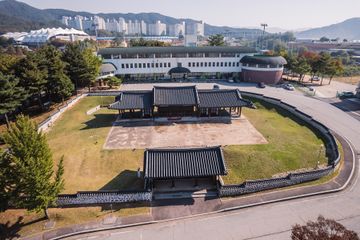안성 객사 정청
| 안성 객사 정청 Shrine Hall of the Guesthouse of the Anseong Local Government |
|
 안성 객사 정청, 국가문화유산포털, 문화재청. |
|
| 대표명칭 | 안성 객사 정청 |
|---|---|
| 영문명칭 | Shrine Hall of the Guesthouse of the Anseong Local Government |
| 한자 | 安城 客舍 正廳 |
| 주소 | 경기도 안성시 보개면 양복리 238-2 |
| 지정(등록) 종목 | 보물 |
| 지정(등록)일 | 2021년 12월 27일 |
| 분류 | 유적건조물 / 정치국방 / 궁궐·관아 / 관아 |
| 소유자 | 안성시 |
| 관리자 | 안성시 |
| 시대 | 고려말~조선초기 |
| 수량/면적 | 정청 1동 |
| 웹사이트 | 안성 객사 정청, 국가문화유산포털, 문화재청. |
해설문
국문
객사는 가운데에 지붕을 높인 정청을 두고, 좌우에 동헌과 서헌을 건립하는 것이 일반적이다. 정청은 임금을 상징하는 전패*를 모시는 공간이며, 동서헌은 지방에 파견 중인 관리들의 숙소로 사용하는 곳이다.
조선시대에는 설날, 임금 탄신일, 매달 보름과 그믐에 임금께 인사드리는 의식을 치렀다. 궁궐에서 의식을 치르는 같은 시간에 각 고을에서는 수령과 아전을 포함한 모든 관리들이 객사 정청 마당에 모여 전패를 향해 인사를 드렸다. 임금이 내리는 명령서인 교서도 객사 정청에서 선포되었다. 따라서 객사는 각 고을에서 가장 중요한 건물이었고, 고을의 중심에 있었다.
안성 객사는 1363년(고려 공민왕 12년) 이전에 건립되었으며, 현존하는 객사 건물 중 가장 오래되었다. 국력이 약해진 1906년부터 전국의 객사는 서서히 폐지되었고, 건물은 학교로 사용되었다. 안성객사도 1908년부터 안성보통학교(현 안성초등학교) 교사로 사용했다. 1931년에는 현 명륜여자중학교로 옮겨졌고, 1995년에 지금의 위치로 옮겨 보존하고 있다. 1842년 경 편찬된 경기도 군현의 읍지인 『경기지 京畿誌』에는 안성객사가 정청이 6칸, 동헌 12칸, 서헌 8칸, 중문 3칸, 외문 3칸, 행랑 4칸, 경운정(鏡雲亭) 6칸이 있었다고 하나 현재는 정청과 동․서익헌만 남아있다.
안성 객사 정청은 사례가 드문 고려말 조선초 주심포 건축**으로 건축 역사에서 중요한 위치를 차지하고 있다. 공포의 구성은 1308년에 건립된 예산 수덕사 대웅전과 비슷하다. 주두는 굽 아래에 받침을 두었고, 살미***와 첨차****는 화려하게 조각했으며, 단면이 항아리 모양인 보를 사용했다. 살미와 살미 사이 중앙에 둥근 모양의 조각을 깎아 놓았는데 이는 안성객사 정청에서만 볼 수 있는 모습이다.
- 전패: 임금을 상징하는 ‘전(殿)’자를 전면에 새긴 나무 패
- 주심포 건축: 공포를 기둥 위에만 배열한 건물 형식
- 살미: 기둥 머리 위에서 정면으로 튀어나와 공포를 구성하는 개별 부재
- 첨차: 기둥 머리 위에서 벽체 방향으로 공포를 구성하는 개별 부재
영문
Shrine Hall of the Guesthouse of the Anseong Local Government
A guesthouse was one of the key buildings of a local government office during the Goryeo (918-1392) and Joseon (1392-1910) periods. It consisted of a shrine in the center, where a wooden tablet symbolizing the king was held, and wings to each side, which were used as temporary lodging for important guests or visiting officials.
During the Joseon period, the local magistrate and officials would gather in the courtyard of the shrine hall to perform rituals of prostrating themselves toward the royal capital. Such rituals were held on the lunar new year and the king’s birthday, as well as on the full moon and new moon of each month. Royal edicts bestowed by the king were also announced at the guesthouse’s shrine hall. Thus, the guesthouse was the most important and central building of each local district.
The guesthouse of the Anseong Local Government is presumed to have been established prior to 1363, making it the oldest extant guesthouse building in Korea. It originally stood at the site of today’s Anseong Elementary School, located about 4.5 km to the west. In the late 19th and early 20th centuries, as national power weakened and administrative districts were reformed, guesthouses nationwide were gradually shut down, and some guesthouse buildings were repurposed into schools. Anseong’s guesthouse was no exception, becoming the predecessor to Anseong Elementary School in 1908. In 1931, the building was moved to the site of today’s Myeongnyun Girl’s Middle School, where it began to be used as a school building again in 1946. In 1995, it was moved to its current location. According to historical records compiled circa 1842, the Anseong guesthouse once consisted of a shrine hall, east and west wings, an inner gate, a main gate, a servants’ quarters, and a pavilion, but only the shrine hall and wings remain today.
The shrine hall of the Anseong guesthouse has maintained its original structure relatively well. It features architectural elements of the late Goryeo and early Joseon periods, of which there are few remaining examples. Such elements include the placement of complex joinery brackets only atop the pillars. The brackets feature ornately carved wings and arms, as well as rounded wing supports that are unique to this shrine hall. For these reasons, the shrine hall holds an important place in Korea’s architectural history.
영문 해설 내용
객사는 고려와 조선시대에 고을 관아에 설치했던 주요 건물 중 하나이다. 객사에는 가운데에 왕의 전패를 모신 정청이 있고, 좌우 양쪽에는 고을을 찾은 중요한 손님이나 관원이 숙소로 사용되던 익헌이 있다.
조선시대에는 설날, 임금의 탄신일, 매달 보름과 그믐에 각 고을의 수령과 관리들이 정청 마당에 모여 임금이 계신 도성을 향해 절을 올리는 의식을 행했다. 임금이 내리는 명령서인 교서도 객사 정청에서 선포되었다. 따라서 객사는 각 고을에서 가장 중요한 건물이었고, 고을의 중심에 있었다.
안성 객사는 1363년 이전에 건립된 것으로 추정되며, 현재 한국에 남아있는 객사 건물 중 가장 오래되었다. 원래 현재 위치에서 서쪽으로 약 4.5km 떨어진 안성초등학교 자리에 있었다. 19세기 말-20세기 초 국력이 약해지고 행정구역이 개편됨에 따라 전국의 객사는 서서히 폐지되었고, 객사 건물들을 학교로 바꿔 사용하게 되었다. 안성 객사도 1908년부터 안성보통학교 교사로 쓰였고, 1931년에는 지금의 명륜여자중학교 자리로 옮겨져 1946년부터 학교 교사로 쓰였다가, 1995년 지금의 자리로 옮겼다. 1842년 무렵 편찬된 경기도 읍지에 따르면 안성 객사에는 정청, 동서 익헌, 중문, 외문, 행랑, 누정 등이 있었지만, 지금은 정청과 동서 익헌만 남아있다.
안성 객사의 정청은 대체적으로 원형을 잘 보존하고 있다. 또한 기둥 꼭대기에만 설치된 공포와 같이, 남아 있는 사례가 많지 않은 고려 말 조선 초의 건축 요소를 잘 보여준다. 공포의 살미와 첨차는 화려하게 조각했으며, 살미와 살미 사이 중앙에 둥근 모양의 조각을 깎아 놓았는데 이는 안성 객사 정청에서만 볼 수 있는 모습이다. 따라서 이 정청은 한국 전통 건축 역사에서 중요한 위치를 차지한다.
참고자료
- 「안건번호 건축 2021-10-019 19. 안성 객사 국가지정문화재(보물) 지정 검토」, 『2021년도 문화재위원회 제10차 건축문화재분과위원회 회의록』, 문화재청, 2021.10.21. https://www.cha.go.kr/cop/bbs/selectBoardArticle.do?nttId=80708&bbsId=BBSMSTR_1019&mn=NS_03_03_04